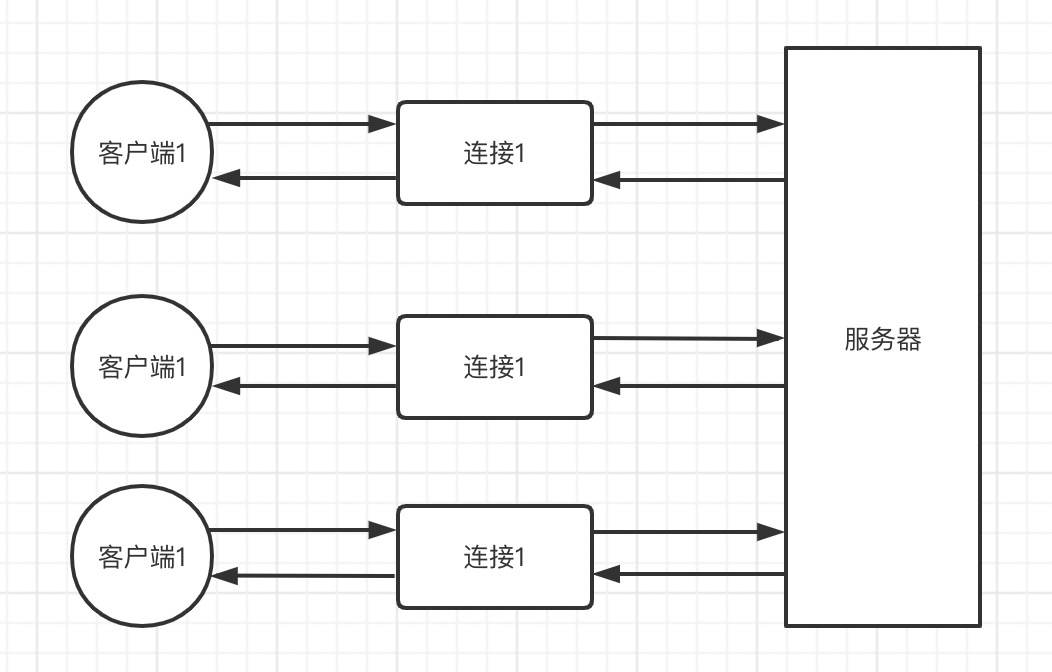netty篇-第一个netty服务器
先了解几个概念:Channel 、 回调、Future、事件和ChannelHandler
放在一起之后:
1. Future、回调、ChannelHandler
2. 选择器、事件、EventLoop
echo服务器的交互方式

编写ChannelHandler和业务逻辑
@ChannelHandler.Sharable//表示一个handler可以被多个channel安全的共享
public class EchoServerHandler extends ChannelInboundHandlerAdapter {
@Override
public void channelRead(ChannelHandlerContext ctx, Object msg) {
ByteBuf in = (ByteBuf) msg;
System.out.println("Server received: " + in.toString(CharsetUtil.UTF_8));
ctx.write(in);//将接收到的消息发给发送者,而不冲刷出站消息
}
@Override
public void channelReadComplete(ChannelHandlerContext ctx) {
ctx.writeAndFlush(Unpooled.EMPTY_BUFFER)//将未解决的消息冲刷到远程节点
.addListener(ChannelFutureListener.CLOSE);//完成之后新增一个关闭channel的监听器
}
@Override
public void exceptionCaught(ChannelHandlerContext ctx, Throwable cause) {
cause.printStackTrace();//如果消息接受出现异常,打印异常信息
ctx.close();//关闭该channel,防止占用资源
}
}编写引导服务器
public class EchoServer {
private final int port;
public EchoServer(int port) {
this.port = port;
}
public static void main(String[] args) throws InterruptedException {
if (args.length != 1) {
System.out.println("Usage: " + EchoServer.class.getSimpleName() +
" <port>");//设置端口值,如果端口参数格式不正确,打印启动帮助信息
}
int port = Integer.parseInt(args[0]);
new EchoServer(port).start();//调用服务器的start方法,开启服务器
}
private void start() throws InterruptedException {
final EchoServerHandler echoServerHandler = new EchoServerHandler();//准备好服务器端的入站处理器
EventLoopGroup group = new NioEventLoopGroup();//准备好处理消息需要使用的eventLoop组
try {
ServerBootstrap bootstrap = new ServerBootstrap();//开始创建启动引导程序
bootstrap.group(group)//设置eventLoop组
.channel(NioServerSocketChannel.class)//设置nio通信管道
.localAddress(new InetSocketAddress(port))//设置服务启动绑定地址
.childHandler(new ChannelInitializer<SocketChannel>() {//将自定义的入栈处理器绑定到处理器列表的最后
@Override
protected void initChannel(SocketChannel ch) {
ch.pipeline().addLast(echoServerHandler);
}
});
ChannelFuture future = bootstrap.bind()//绑定之后
.sync();//同步
// 这个语句的主要目的是,如果缺失上述代码,则main方法所在的线程,即主线程会在执行完bind().sync()方法后,
// 会进入finally 代码块,之前的启动的netty server也会随之关闭掉,整个程序都结束了。
future.channel()
.closeFuture()
.sync();
} finally {
group.shutdownGracefully().sync();
}
}
}编写echo客户端的业务处理逻辑
@ChannelHandler.Sharable
public class EchoClientHandler extends SimpleChannelInboundHandler<ByteBuf> {
@Override
protected void channelRead0(ChannelHandlerContext ctx, ByteBuf msg) {//记录已接受消息的转储
//todo 可以做一些消息的转储,消息被读取的时候调用
System.out.println("Client received: " + msg.toString(CharsetUtil.UTF_8));
}
@Override
public void channelActive(ChannelHandlerContext ctx) {//当被通知channel是活跃的时候,发送一条消息
//新连接被建立的时候调用
ctx.writeAndFlush(Unpooled.copiedBuffer("Netty rocks!", CharsetUtil.UTF_8));
}
@Override
public void exceptionCaught(ChannelHandlerContext ctx, Throwable cause) {
cause.printStackTrace();
ctx.close();
}
}编写echo客户端
public class EchoClient {
private final String host;
private final int port;
public EchoClient(String host, int port) {
this.host = host;
this.port = port;
}
public void start() throws InterruptedException {
EventLoopGroup group = new NioEventLoopGroup();//每个客户端启动都需要先创建一个eventLoop组
try {
Bootstrap bootstrap = new Bootstrap();//创建客户端的启动器
bootstrap.group(group)
.channel(NioSocketChannel.class)//设置channel类型
.remoteAddress(new InetSocketAddress(host, port))
.handler(new ChannelInitializer<SocketChannel>() {//设置channel初始化方法
@Override
protected void initChannel(SocketChannel ch) {
ch.pipeline().addLast(new EchoClientHandler());
}
});
ChannelFuture future = bootstrap.connect().sync();//连接同步
future.channel().closeFuture().sync();//为防止程序关闭资源直接被释放,这里加个关闭同步
} finally {
group.shutdownGracefully().sync();
}
}
public static void main(String[] args) throws InterruptedException {
if (args.length != 2) {
System.out.println("Usage: " + EchoClient.class.getSimpleName() +
" <host> <port>");
}
String host = args[0];
int port = Integer.parseInt(args[1]);
new EchoClient(host, port).start();
}
}直接启动